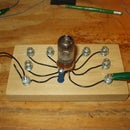Introduction: Understanding How AM Radios Work.
If you have an understanding of how AM radio work then you have a basic understanding of how radio and even TV works.
In an effort to make all this understandable to the novice some of the explanation may be oversimplified.
For now just read this next part and don't try too hard to understand too much. At the transmitter, an oscillator set to the frequency of the station and connected to the antenna, is modulated by the microphone. This oscillator creates a wave of energy that exits the antenna and travels out through the air.
These energy waves are everywhere. Thousands of them are hitting your body right now. Every piece of metal or conductor is absorbing them. They go out into space and even into the ground and under water. They are even coming from outer space.
Step 1: Radio Sections
Even the most basic radio consists of several sections.
The first section is the antenna. Every radio must have some kind of antenna. It is what captures part of this wave of energy. If the antenna is tuned to the frequency of the radio station it will be more efficient in bringing energy to the radio
The next section is the tuner. This section takes all of the energy waves that collect on the antenna and removes all but the one you are trying to listen to. The tuner in a crystal set may tune more than one station at a time if there are strong stations near. The tuner of a more sophisticated set will be able to separate stations very well.
The next section is the detector. This can be be a diode, a sharp wire touching a piece of galena or fools gold or a rusty razor blade. It's purpose is to rectify the signal that has been tuned by the tuner.
The last section in a simple radio set is the sound reproducer. In a crystal set or low powered set this would be a headset or earphones.
There may be other sections to a more sophisticated radio set but they are there just to add to what these four sections are doing.
Step 2: Antenna
The antenna is or can be just about any piece of metal. The better the radio the less antenna you need. to a certain extent. In a basic crystal radio you need a long antenna and it needs to installed as high as possible. If you're close to the transmitter you might be able to get by with just some wire strung in the attic or across the ceiling.
Step 3: Tuner
The tuner consists of a coil and wiper. They take the energy that the antenna gathers and if adjusted correctly will be resonant at the frequency that the station is broadcasting. The coil will pass that frequency only to the detector.
Step 4: Detector
The detector can be made of a blued razor blade and a safety pin, or it can be a germanium diode. It's purpose is to take the the high frequency electricity and convert it into audio frequency electricity that mimics the original program.
Step 5: This Is the AM Carrier Wave
If you listen to this you won't hear anything because it oscillating at 800 thousand or maybe 1700 thousand cycles per second. That's way too fast to hear. Most of us can here 20 thousand cycles of so and no higher. But this carrier wave is very important to radio transmission. It's what will be modulated or shaped to mimic the sound of the radio program. The green horizontal line represents 0 and the top represents most positive and the bottom represents most negative. And it should be drawn as a nice sine wave so this is just a quick sketch.
Step 6: Modulated Carrier Wave
Modulated means to shape the carrier wave so the the amplitude mimics the radio program. That's the curved line in the drawing. The amplitude of the wave is made higher or lower to carry the audio of the radio program. But you still won't hear anything unless it goes through the detector. The reason for this is that the signal is as positive as it is negative, so the earphones just don't make any sounds.
Step 7: The Detected Signal
THIS is the detected signal. Now we have a varying signal that goes from 0 to positive duplicating the original audio program. It's still at the frequency of the transmitter though. But, if we connect sensitive headphones to the output of the coil and a ground, you will hear the transmitted radio program. The frequency of the transmitter is much too fast for the earphones to respond to but the frequency of the modulated signal is in the audio band and this is what the earphones can respond to. Now you hear your program.
The second drawing is how the earphones respond to the detected signal.













